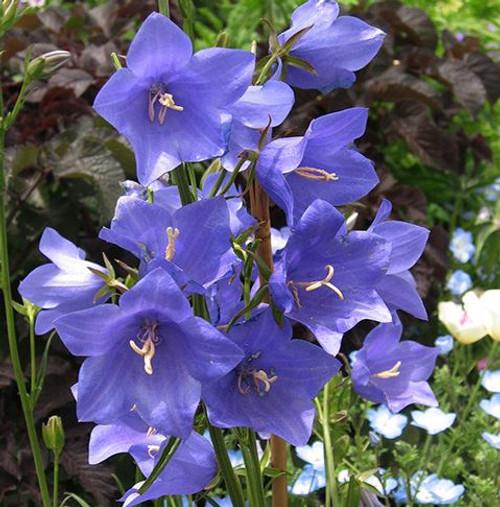Campanula syn. Azorina, commonly known as Bellflower, Ivory bells, Bearded bellflower, Fairies’ thimbles, Adriatic bellflower, Clustered bellflower, Falling stars, Italian bellflower, Star of Bethlehem, Milky bellflower, Canterbury bells, Cup and Saucer, Peach-leaved bellflower, Dalmatian bellflower, Chimney bellflower, Bluebell, Harebell, Bats in the belfry, Nettle leaved bellflower, Throatwort are annuals, biennials and perennials, some of which are evergreen. They are widely distributed throughout the temperate zones of the N. hemisphere, particularly in S. Europe and Turkey. Grows in diverse habitats from high alpine rock crevices and scree to moorland, meadows and woodland. Most are easily cultivated and provide a long flowering display from late spring to late summer. Campanulas vary in habit from mat forming, dwarf perennials to herbaceous species that grow up to 6 ft. (2m) tall.
Dwarf campanulas are ideal for a rock garden or alpine house. Many grow well on a wall or sunny bank. Where not hardy, grow under glass in soil-based potting mix, in bright filtered light with good ventilation.
USES: Alpine gardens, Meadow gardens, Walls, Woodland gardens, Rock gardens, Mixed or herbaceous borders, Wildflower gardens, Woodland gardens, Perennial gardens
Botanical Name: Campanula glomerata var. dahurica ‘Superba’, ‘Odessa’
Common Name: Clustered Bellflower, Dane’s Blood, Knäuel-Glockenblume
Type: Vigorous, rhizomatous, spreading Perennial
Flower Color: Wide, deep purple-violet flowers
Flowering Time: Summer
Plant Height: 24 in. (60cm)
Plant Width: 24 in. (60cm)
Light Requirements: Full Sun. Partial shade in hot summers.
Water Requirements: Moist
Soil Requirements: Fertile / Neutral to Alkaline / Well drained soil
USDA Zone: 3-8
AHS Heat Zone: 8-1
Sowing Instructions (Cliff Notes Version): Sow seed in containers in a cold frame in spring, except for alpines which should be sown in an open frame in autumn.
Click here for Planting Instructions









